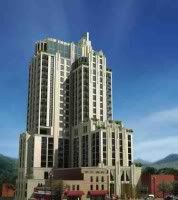 What's pictured here is a model of a proposed 23 story luxury high-rise on Biltmore Avenue downtown. If y'all have been following the story, you'll know that a lot of people who chant "Growth is Inevitable" like this building, called The Ellington. They see it as good density and the "right" kind of development. Many others see the building as a future blight on our economy and an unnecessary transformation of our downtown from what-the-locals-like to what-the-tourists-want. All of that will be very fun to talk about at blogs like Scrutiny Hooligans, Brainshrub, Et In Arcadia Ego, 1000 Black Lines, and the inimitable Ashvegas. Since here at BlogAsheville we're decidedly nonpartisan, hardly political (unless you count DL announcements), and unlikely to turn the place into a madcap growth and development argument, this post isn't about The Ellington. It's about the man and the building whose name and style the developers have adopted.
What's pictured here is a model of a proposed 23 story luxury high-rise on Biltmore Avenue downtown. If y'all have been following the story, you'll know that a lot of people who chant "Growth is Inevitable" like this building, called The Ellington. They see it as good density and the "right" kind of development. Many others see the building as a future blight on our economy and an unnecessary transformation of our downtown from what-the-locals-like to what-the-tourists-want. All of that will be very fun to talk about at blogs like Scrutiny Hooligans, Brainshrub, Et In Arcadia Ego, 1000 Black Lines, and the inimitable Ashvegas. Since here at BlogAsheville we're decidedly nonpartisan, hardly political (unless you count DL announcements), and unlikely to turn the place into a madcap growth and development argument, this post isn't about The Ellington. It's about the man and the building whose name and style the developers have adopted.Most every story on the Ellington gives some background into the building's name and alleged inspiration, but HeritageWNC.org has the most thorough piece I've seen:

"Rising proudly to the Carolina blue sky with a rush of Georgia pink marble, the Asheville City Building has stood in downtown Asheville since 1927. Designed in the Art Deco style (known as the Style Modern or Neo-Romantic in the 1920s) by architect Douglas Ellington of Asheville, the Asheville City Building serves as a landmark for the city of Asheville’s unique artistic expression and as a reminder of Asheville’s progressive spirit and its economic boom before the Great Crash of 1929.5,25 Towering over the City Building in an imposing Neo-Classical style, the Buncombe County Courthouse serves as a landmark of the county’s commitment to traditionalism and security."
[...]
"Originally in 1926, Ellington had planned that twin Art Deco style buildings with a promenade connecting the city building to the county courthouse would comprise the city-county Civic Center. Later in 1926, Ellington revised the courthouse design by the specifications that county officials had requested while maintaining the courthouse’s Art Deco style that worked so harmoniously with the City Building."
[...]
"As it stands today, the Civic Center itself represents the contrast and occasional conflict between Asheville and Buncombe County. The Asheville City Building represents the progressive and artistic spirit that was propelling Asheville forward in the 1920s but also was amassing a huge debt for the Asheville and Buncombe County area, upwards of 50 million dollars.17 The Buncombe County Courthouse represents the conservative, traditional, and safe reasonability that had supported the county for so long yet was finding it difficult to adapt to the changes of the time."
No comments:
Post a Comment